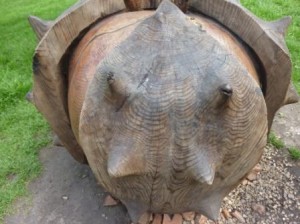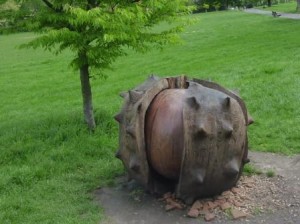Storytelling Starters ~ Giant Children
 I’m currently reading a Welsh novel, Y Storïwr, by the journalist, broadcaster and author Jon Gower. Published in 2011, its title, translated, means The Storyteller and I’m fascinated. For one thing, the baby that’s born at the start of the book is so like the baby Taliesin in the ancient Welsh story I told at the London Welsh Centre as part of the Bloomsbury Festival just a couple of weeks ago. In the old Welsh legend, the little Taliesin is found inside a leather bag floating on the waters of a magical weir and he begins to speak almost as soon as he’s found. First he declares his name – and then, since he is destined to become a renowned Welsh poet, when he goes on speaking he naturally does so in the recognisable metres of Welsh poetry.
I’m currently reading a Welsh novel, Y Storïwr, by the journalist, broadcaster and author Jon Gower. Published in 2011, its title, translated, means The Storyteller and I’m fascinated. For one thing, the baby that’s born at the start of the book is so like the baby Taliesin in the ancient Welsh story I told at the London Welsh Centre as part of the Bloomsbury Festival just a couple of weeks ago. In the old Welsh legend, the little Taliesin is found inside a leather bag floating on the waters of a magical weir and he begins to speak almost as soon as he’s found. First he declares his name – and then, since he is destined to become a renowned Welsh poet, when he goes on speaking he naturally does so in the recognisable metres of Welsh poetry.
A Magical Future?
In Jon Gower’s novel, the baby that emerges to the working-class world of an extremely character-full South Wales village is born with the birthmark of a dragon. His future is obviously destined to become extraordinary and he is certainly surrounded by a cast of legend-like people. How will the baby turn out? I have few clues yet except that, on his first day in school, having already acquired through diligent research a quite phenomenal vocabulary and having already demonstrated a striking capacity for unusual speech, the little boy aged only four stands up when the teacher is going round her class asking children their names and tells a long, gripping story (in theory about an ancestor). For doing this – not altogether surprisingly – he earns the hatred of the other children.
 What is going to happen to Gwydion, for that is what Jon Gower’s hero is called, he having been named because of his birth-mark after the magician figure in the Mabinogion?
What is going to happen to Gwydion, for that is what Jon Gower’s hero is called, he having been named because of his birth-mark after the magician figure in the Mabinogion?
I shall be finding out. Meantime, for some reason – perhaps the preternatural flash of intelligence, perhaps something about being associated with the giant figures of Welsh mythology – Jon Gower’s book has reminded me of an incident with an Early Years class of children in Pembroke which I think I’ve mentioned in this Blog before. It’s one of the pieces of evidence I would put into any dossier of evidence I assembled about the value of storytelling in education. Now I’ve written it up as one of the true-life tales I’ve recently been focusing on. I’ve called it – not surprisingly – Giant Children.
Giant Children
The morning was part of one of my storytelling training courses for Pembrokeshire teachers. I loved these courses. Each involved a small group of teachers coming together from different schools. The work was immediate, practical and engaging and – one of the things I liked most about it – it was always up to the teachers how they interpreted it and carried it on when they were back in their own classrooms. Another thing to be appreciated was that, luxuriously by current standards, we were able to meet on so many occasions, five half-day sessions over the course of a term. It was a brilliant way to embed the work and on each occasion of meeting, before and after going into the classroom, the teachers had time to share with me and each other what they were making of the stories and the telling.
This was one of the classroom sessions where the participating teachers would come with me into a classroom to observe me telling the day’s story to the particular class of children which had been selected as the focus for that particular course. It was a Reception-age class, so they were all young children of about four years of age, and now they were gathered on the carpet before me in the regular place we’d established for our storytelling. The visiting teachers had dotted themselves round the edges and I was sitting as usual on a low child-size chair, higher than the children but not so far above as if I’d been on an adult-size chair.
The story on this day’s occasion was one I always refer to as Little Bear on the Long Road. It’s a good one for this age-group and, whenever I tell it, I feel grateful to the person from whom I originally heard it. This was the wonderful Japanese storyteller, Kyoko Matsuoka, who told it to me on an occasion when we’d arranged to meet to talk about the work of Eileen Colwell, the pioneering English storyteller who’d been an inspiration to both her and me and, of course, to so many others.
So there we were in the British Library Tea-room, the place where we’d agreed to meet, and after talking about Eileen’s influence, we got on to talking about stories for very young children. Kyoko and her colleagues in Japan had been making collections of these and, mentioning one I didn’t recognise, Kyoko said she’d tell it to me. Reaching down to her handbag, she pretended to take out of it a small teddy-bear as a prop for telling the story and gracefully raising this invisible prop to her left shoulder – I swear I could see it perched there! – she then launched out on the story of Little Bear’s adventures as he went out of his garden gate – and, yes, I actually heard it squeak! – and saw the start of a very long road opening up before him the other side of the gate. And, yes, I actually saw the long road too when Kyoko, like magic, raised her left arm and, unabashed in the British Library tea-room, – stretched it out before her.
The Little Bear that I use for the story is very soft and a golden yellow and quickly endears himself to children. Their responses reveal their engagement and what also struck me on this particular occasion in that Pembrokeshire classroom what has often struck me before, namely the intelligence and humour young children can show, the brilliance of their ability to empathise and visualise, understanding perspective with the same natural instinct as if they were birds on the wing.
Little Bear had just got to the end of his journey along the length of my arm. He’d climbed the hill my raised elbow presented, slid down the other side of it with a merry cry of enjoyment and successfully jumped over the river that my wrist-watch became. Arriving at the end of my fingers and seeing the drop that loomed below and beyond them, he’d taken his first quick look over the edge to determine what could be there. ‘What could it be?’ I asked in his voice and mine as, for the second time, he looked into the abyss. In the small, expectant silence that followed, I waited to see what might be said. Dolphins, sharks, a lonely little bear – there’s generally no lack of answers.
It was the big new boy at the front who spoke up first on this occasion, a boy who had apparently only joined the class about a fortnight before. Sitting or standing, he was a full head higher than the rest and his voice surprised me with its strength and humour as, with an amused look in his eye, he looked up at Little Bear and me and, as if he himself was Little Bear looking down, firmly announced, ‘Giant children’.
P.S. My photos this week are of the Giant Conker – an extraordinary carving that magically arrived one day in Brockwell Park, my local park. One of the things I love about it is the number of children that rush up and hug it, loudly calling out: ‘Is it real?’
Tags: Giant Conker, Gwydion, Jon Gower, Kyoko Matsuoka, Little Bear On The Long Road, Pembrokeshire, props, teachers' courses, teddy bear, The Mabinogion, Y Storiwr


